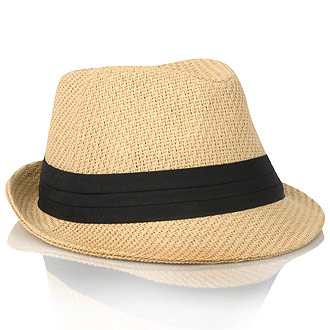The Last Straw

The rule of thumb, in the United States at least, is that one does not wear white after Labor Day. That tradition dates back to the 1800s but, as mental_floss explains, its origins of it are not definitively known. But it is not the only odd fashion tradition in the United States. In the early 1900s, wearing another piece of clothing was verboten after the close of summer: straw hats.
And in one case, this informal ban led, dramatically, to violence.
In the mid-1800s, a portion of lower Manhattan then known as the Five Points became a breeding ground for organized crime and slums. The working-class gangs — portrayed in fiction in the movie Gangs of New York — operated outside and often above the law, and would later become the breeding grounds for famous Prohibition-era crime bosses such as Al Capone in their early days as gangsters. And some of their criminal activity was just plain weird — idle maliciousness more than anything else. The best example of this may be the Straw Hat Riots of 1922.
For years, the fashion culture dictated that men wear hats. But not all hats were acceptable at all times. After September 15th, straw hats were simply not to be worn. Why is anyone’s guess, and why that date in particular doubly so. Regardless, the date permeated the culture, creeping forward from what appears to be an original “last day” of September 1st. As noted by Put This On, many newspapers printed warnings about the informal deadline. For example, on September 14, 1912, the Lawrence (Kansas) Daily Journal-World warned men that “the man who ventures out on the streets after tonight with a straw hat on is in danger of being hauled before the bar of judgment and made to explain his conduct.” It is not likely that many (if any) men actually were imprisoned for wearing straw hats toward the end of September, but some certainly took the restrictions seriously.
On September 13, 1922, some gang members from the Five Points area decided to get a head start on the straw hat ban. They went to a local factory, took the straw hats from workers there, and smashed them. Then they took aim at dock workers on the East River (separating Manhattan from Brooklyn), but unlike the factory workers, the dock workers fought back. The ensuing riot was so bad that traffic over the Manhattan Bridge came to a halt until police arrived. As the New York Times reported the next day (pdf), hat-smashers were threatened with arrest:
The inalienable right of a man to wear a straw hat in a snowstorm, if he so desires, is to be upheld in this city by both police and the Magistrates, and a warning was sent to all straw hat smashers last night that jail terms on assault charges awaited them if they started any such carnival today [September 14th].
They continued nonetheless. Armed with sticks, often adorned with nails, the rioters — perhaps numbering as many as 1,000, per an Associated Press report — mashed more and more hats, well outpacing any police intervention. (It is likely that the first police on the scene were off-duty officers who were, at first, victims — men who had their straw hats destroyed by rioters.) It took the police until the 15th to quell the riots.
Straw hat riots would return in subsequent Septembers for a few years, even claiming the life of a straw hat-clad man who tried to defend his hat for some reason. Over time, the social requirement that men don hats relaxed, and the smashing habit went away, too.
Bonus fact: Straw hats may not be the only headgear out there that causes pandemonium. In 1797, an English haberdasher by the name of John Hetherington took to wearing an early version of the top hat — with ridiculous results. According to Hetherington’s Wikipedia entry, citing Hatters Gazette, the silk band on the hat was “calculated to frighten timid people” and resulted in exactly that ill: “several women fainted at the unusual sight, while children screamed, dogs yelped and a younger son of Cordwainer Thomas was thrown down by the crowd which collected and had his right arm broke.” For his “crime,” Hetherington was charged with breach of the peace and inciting a riot, and released on a bond of 500 pounds.
Take the Quiz: Name the People Famous for Their Hats (or, famous, but recognizable by their hats, I guess).
From the Archives: Reading Them the Riot Act: The origins of that turn-of-phrase.
Related: A $1,500 straw hat. Not worth dying over, though.

Leave a comment